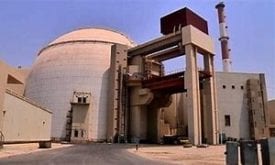Radiofarda – Iran’s military expenditures have been declining, writes Iranian military analyst Hossein Aryan in an analysis for Radio Farda’s Persian website based on data released by the Stockholm International Peace Research Institute (SIPRI).
The decline in Iran’s military spending comes against a backdrop of rising tensions between Iran and Saudi Arabia, and these two countries as well as Qatar and the United Arab Emirates have been calling for a more active role in regional developments.
Saudi Arabia and the UAE have deployed their forces to confront Iran-backed Houthis in Yemen. Qatar and UAE are also involved in the civil war in Libya, and Iran has sent troops to Syria and Iraq to support the governments there, Aryan writes.
SIPRI’s review of military strength in the region maintains that Iran’s military expenditures reached its peak in 2006 but had declined 30 percent by 2014. The decline in Iran’s military spending was most pronounced during 2012-2013 as a result of EU sanctions against the country.
Following the nuclear agreement with the West in 2015 and the lifting of some of the sanctions imposed on Iran by the European Union and the United States, Tehran increased its military spending up to 25 percent.
In 2018, as a result of the economic recession and high inflation, which reached 30 percent, Tehran’s military expenditures were reduced by 9.5 percent and reached $13.2 billion, or 2.7 percent of the country’s gross domestic product (GDP). That same year, Iran ranked 25th on the list of military expenditures in the world.
In the meantime, purchases and imports of weapons by Iran dropped drastically in the 25 years between 1994 and 2018 and were much lower than the number of weapons imported by its Arab neighbors Saudi Arabia, Qatar, and the UAE.
Between 2009 and 2018, Iran’s weapons imports amounted to only 3.5 percent of Saudi Arabia’s imports.
The decline in weapons imports by Iran was mainly the outcome of two factors: limitations in its budget as a result of the country’s economic bottlenecks and limitations imposed by UN Security Council resolutions that banned the sale of weapons to Iran until the end of 2020.
Iran’s most important arms imports took place in 2016, when Tehran received the S-300 air defense system from Russia, benefitting from the exemptions mentioned in the UN resolutions.
While the littoral states on the southern shores of the Persian Gulf can fulfill their requirements for weapons from many countries, only a limited number of weapons manufacturers are willing to sell arms to Iran.
Between 2014 and 2019, 96 percent of Iran’s weapons imports came from Russia. The rest were provided by China.
At the same time, as Iran follows a policy of self-sufficiency, it has been manufacturing some of its major weapons such as ballistic and cruise missiles as well as drones in an attempt to make up for limitations in the area of importing weapons.
During the past 25 years, Iran — like Saudi Arabia, Qatar, and the UAE — has spent an increasing share of its GDP on military needs.
While Saudi Arabia spent $67.4 billion on its military in 2018 and ranked the fifth-biggest spender in the world, Iran in the same year spent $13.2 billion, about one-fifth of Saudi Arabia’s expenses.
Between 2014 and 2018, the UAE and Saudi Arabia imported weapons mainly from the United States and Western Europe, adding a variety of advanced technology to their military capability, while Iran’s imports during the same period were negligible.
 Shabtabnews In this dark night, I have lost my way – Arise from a corner, oh you the star of guidance.
Shabtabnews In this dark night, I have lost my way – Arise from a corner, oh you the star of guidance.


